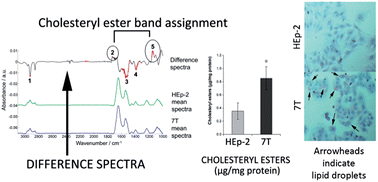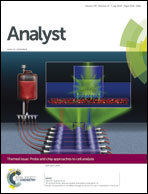FTIR spectroscopy reveals lipid droplets in drug resistant laryngeal carcinoma cells through detection of increased ester vibrational bands intensity†
Abstract
The major obstacle to successful chemotherapy of cancer patients is drug resistance. Previously we explored the molecular mechanisms of curcumin cross-resistance in carboplatin resistant human laryngeal carcinoma 7T cells. Following curcumin treatment we found a reduction in curcumin accumulation, and reduced induction of reactive oxygen species (ROS) and their downstream effects, compared to parental HEp-2 cells. In order to shed more light on mechanisms involved in drug resistance of 7T cells, in the present study we applied Fourier transform infrared (FTIR) spectroscopy, a technique that provides information about the nature and quantities of all molecules present in the cell. By comparing the spectra from parental HEp-2 cells and their 7T subline, we found an increase in the intensity of ester vibrational bands in 7T cells. This implied an increase in the amount of cholesteryl esters in resistant cells, which we confirmed by an enzymatic assay. Since cholesteryl esters are localized in lipid droplets, we confirmed their higher quantity and serum dependency in 7T cells compared to HEp-2 cells. Moreover, treatment with oleic acid induced more lipid droplets in 7T when compared to HEp-2 cells, as shown by flow cytometry. We can conclude that along with previously determined molecular mechanisms of curcumin resistance in 7T cells, these cells exhibit an increased content of cholesteryl esters and lipid droplets, suggesting an alteration in cellular lipid metabolism as a possible additional mechanism of drug resistance. Furthermore, our results suggest the use of FTIR spectroscopy as a promising technique in drug resistance research.


 Please wait while we load your content...
Please wait while we load your content...